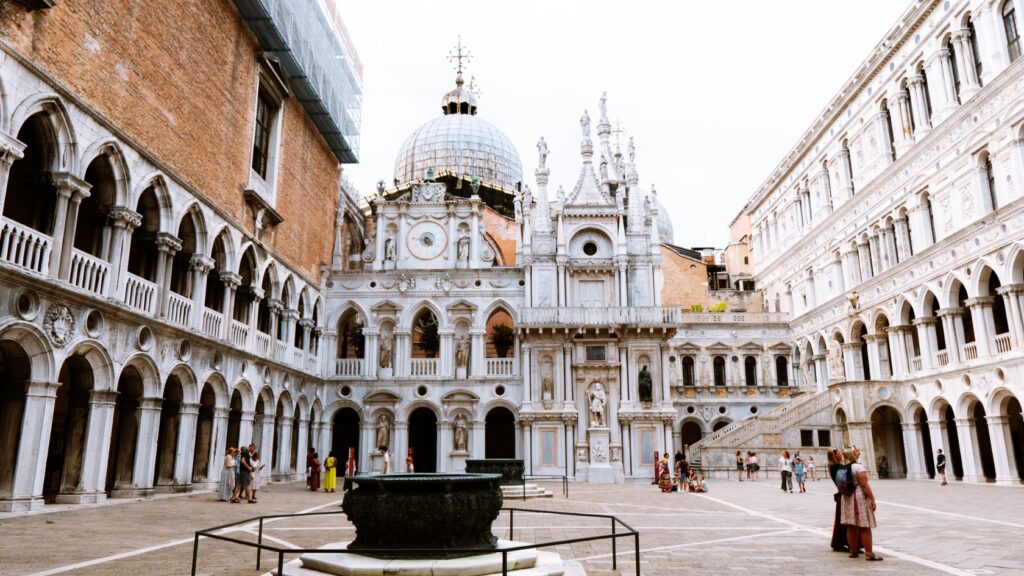Planning what to see and what sights to visit in Venice? Check out our 25 tips for the best places to visit in Venice + 5 tips for things to do around Venice.
We update admission fees, opening times and other useful information for sights in Venice several times a year. The latest update is always listed at the beginning of the article.
- Venice in Italy
- 25 tips on the best places to visit in Venice
- 5 tips for day trips around Venice
- Where to stay in Venice
- Tips on the best places and things to see in Venice: MAP
- Practical information on how to enjoy Venice
- How to save in Venice
- More information about Italy
- Summary: What to see and do in Venice
Venice in Italy
Venice is a city of almost 300,000 people in the north-east of Italy. It is one of the most popular destinations, with 27.5 million tourists a year.
For more than 1,000 years, Venice was an independent empire until Napoleon took over in 1757.
Between the 13th and 18th centuries, Venice was one of the richest commercial centres in Europe, which is why most of its buildings date from this period. At 14th century, they even controlled most of the Mediterranean, including Crete, Zadar and Cyprus.
The city has so much strict laws on historical monuments that its appearance has remained almost unchanged for centuries. Venice is literally through a labyrinth of narrow alleys and shortcuts that even the best map apps can’t take. Just walk around and soak up the atmosphere in the backstreets.
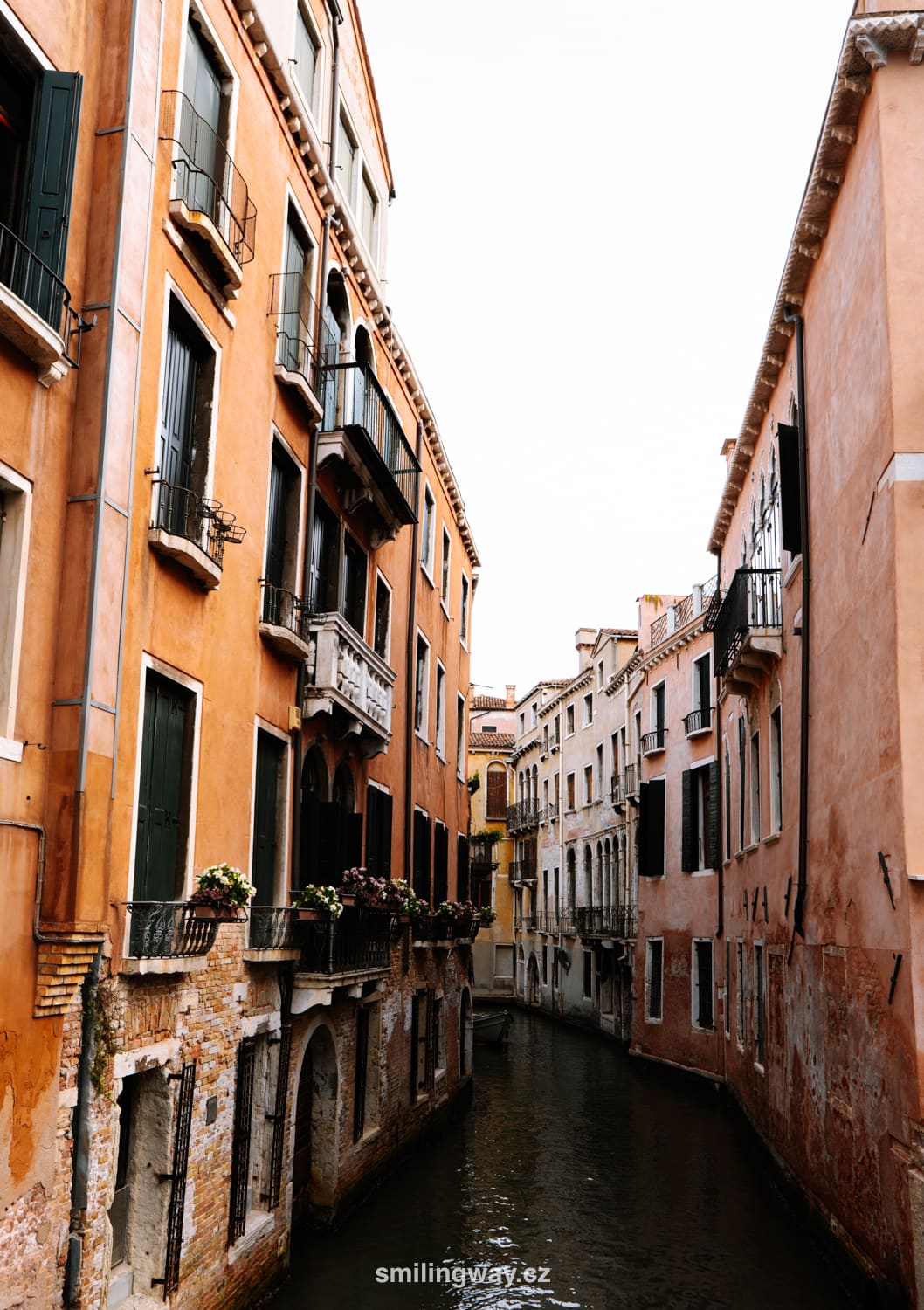
25 tips on the best places to visit in Venice
Venice is not popular for nothing. There are plenty of beautiful places to go in Venice.
Monumental basilicas and opulent palaces that house breathtaking art collections, romantic canals that you can take a gondola ride over or cross on one of the iconic bridges, and plenty of alleyways to wander.
Venice is unique. They have their own specific atmosphere that you can’t find anywhere else.
How to skip the line: From spring to autumn, Venice is packed with tourists and long queues form at the most popular sights. For this reason, we have booked tickets in advance. On the spot, we just showed the tickets on our mobile phones and could go right in.
Let’s do it: what are the most beautiful sights in Venice and what are the interesting places to see?
1. Piazza San Marco
We start in the heart of Venice. Where the biggest crowds of tourists flow. At the centre of Venetian public and religious life.
Piazza San Marco is the central square of Venice, 180 metres long and 70 metres wide. It is the only square in Venice. Other “squares” are called piazzalles or campos.
Napoleon called Piazza San Marco the reception room of Europe.

The square represents the lowest point in Venice. During the Acqua Alta (Big Water) it is the first to be flooded. Sometimes it’s just a bigger puddle, but sometimes the whole square is flooded. This happens several times a year due to the influx of the Adriatic Sea. Especially in autumn (from November) and winter.
As soon as the level starts to rise, sirens are triggered to warn the population. Authorities will then place several raised walkways to allow locals and tourists to pass through.
It is an interesting spectacle, but it is also sad because it devalues the historical heritage that is listed by UNESCO.

Piazza San Marco is surrounded by several of Venice’s most important monuments – St Mark’s Basilica, the Doge’s Palace, the Clock Tower and the Museo Correr.
You can have a coffee in one of the two cafés and just enjoy. And they’re not just any coffee shops. One is said to be the oldest in the world and the other the oldest café still operating in the world.

If you want to avoid the crowds and enjoy the atmosphere almost to yourself, head here early in the morning or later in the evening, when the square is beautifully lit. Venice is not a night city. Most of the bars and restaurants close around 11pm, so the city is much more crowded relatively early in the evening.

2. Basilica of St. Mark (Basilica di San Marco)
One of the most beautiful basilicas in Italy. St Mark’s Basilica dominates Piazza San Marco.

It is built of more than 500 marble columns from 3rd century. The 4000 square meters of glittering golden and Murano coloured glass mosaics, statues, 5 Byzantine domes and a golden altar studded with jewels will win you over.
It is called Chiesa d’Oro or Golden Church because of its ornate and golden interiors.
Do you know what the reason for building the basilica was? In 828, Venetian merchants smuggled the body of Saint Mark the Evangelist (one of the 12 Apostles) out of Egypt past Muslim guards and hid it in a vat of lard. It was in the basilica that the body was then buried.


Originally the basilica was supposed to be an extension of the Doge’s Palace. The Basilica of San Marco was later burned and in 11. It was rebuilt by the Venetians in the 11th century. Over the centuries, it has been modified and renovated into its present form in the shape of a Latin cross.
Please note: Remember to dress appropriately – in summer you need to cover your knees and shoulders. They won’t let you in even with a larger backpack (you can leave it in the luggage room in Piazzetta dei Leoncini, to the left of the main entrance).
Admission and opening hours of the Basilica of San Marco in Venice
The Basilica is open 9:30-17:15 (last entry 16:45) and 14:00-17:00 on Sundays (closes at 16:00 in winter). Arrive as early as possible in the morning – in season and on weekends at 9am – and join the queue. Later, the queues are really long. Moreover, early in the morning you have the opportunity to see the whole square without crowds of tourists.

Entrance to the basilica is for €3. For another €5 you can see the Golden Altar and for €7 you can go to the Museum di San Marco, where you can enjoy the view from the terrace overlooking the square and get a closer look at the mosaics or the original bronze horses of St Mark (interestingly, they are mostly made of copper). These were brought by the Venetians from 4. Crusade from Constantinople in the 4th century. Replicas of the horses are right on the façade of the basilica.
Children under the age of 6 can enter all parts of the basilica for free.


How to skip the lines for St. Mark’s Basilica:
We were buying combined tickets in advance at 9:30am – included the basilica, the Golden Altar, the museum and a view from the terrace. We went through the entrance on the left reserved for advance reservations, where only a few people were waiting. To the right of this is the entrance for those without a reservation – the queue was already long at opening time all the way to the Doge’s Palace.
You can also attend one of the services, entering the basilica through the Porta dei Fiori entrance from Piazzetta dei Leoncini.
3. Campanile di San Marco (Campanile di San Marco)
St Mark’s is a 98.6 metre long tower, the tallest building in Venice. At its top is a golden statue of the archangel Gabriel. The belfry consists of 5 bells. Everyone had a purpose during the Venetian Republic:
- Marangona’s biggest bell rang at the beginning and end of the day,
- Malefico is the smallest and sounded during the execution,
- Nona’s bell announced noon,
- Trottner convened the members of the Maggior Consiglio,
- and the last bell of the Mezzaterzah announced the Senate in session.

The Campanile di San Marco was originally built as a lighthouse for sailors. Today you will enjoy a magnificent view of the city. A comfortable, manned lift takes you up to the observation deck.
The view from Campanile di San Marco is charged at € 10 (children under 6 years old are free). Only 30 people are allowed in every 30 minutes, so it’s best to book tickets in advance. Then you go right at the entrance. On the left are those who don’t have a reservation.
Opening hours of the bell tower are 9:45-19:00.

Tickets for the most popular sights in Piazza San Marco, where long queues form:
4. The Doge’s Palace (Palazzo Ducale)
We’re staying in St. Mark’s Square. We walk a short distance from the basilica and stand in front of the Doge’s Palace.
You can imagine it as a magnificent building, which is considered a masterpiece of Venetian architecture with its mixture of Gothic, Byzantine and Moorish styles.
In the past, the Doge’s Palace served as the residence of the Doge, the government and also as a prison. For example, Cassanova was imprisoned here.



Admission and opening hours of the Doge’s Palace
Admission is €30 and it is open daily 9:00-19:00 (last entry one hour before). In winter it closes at 18:00.
How to skip the queues for the Doge’s Palace:
Everyone wants to go to the Doge’s Palace and the queues are long. Especially in the season it is advance booking is a must to avoid long queues (the price is the same as on site). Just show the tickets on your mobile phone, you don’t need to print anything. You will go through a reserved entrance for tickets booked in advance.
The ticket includes entry to the Museo Correr and the National Archaeological Museum, and the monumental rooms of the National Library of Marciana (we’ll tell you in a moment if it’s worth a visit).
5. Bridge of Sighs
If you continue past the palace along the promenade, you will see the Bridge of Sighs (Ponte dei Sospiri). This connected the prison with the interrogation rooms in the Doge’s Palace.
It takes its name from the prisoners who sighed on the bridge that it was probably the last time they would see the Venice Canal.
The Bridge of Sighs can also be crossed during a tour of the Doge’s Palace.

6. Museo Correr
The Museo Correr is the most famous museum in Venice, which includes objects and works of art related to the history of the city, from its foundation to the unification of Italy in the 19th century, including an old map of Venice.
Entrance is free with your ticket to the Doge’s Palace. It also includes access to the National Archaeological Museum, with its large collection of marble and bronze sculptures, and the Marciano National Library, whose main hall is decorated with art by Veronese, Tintoretto and Titian.
Ticket to the Doge’s Palace, the Museo Correr, the National Archaeological Museum and the National Library of Marciana will cost you €30. Higher price, but well worth it if you want to see the beautiful spaces, the art, get a glimpse of Venice’s rich history and enjoy the great view of Piazza San Marco.
Hotels in Venice 😴
7. Torre dell´Orologio
The Torre dell’Orologio is a stunning clock tower from the 15th century. On St Mark’s Square, to the left of the basilica, it’s a magnificent monument you won’t want to miss.

It has a distinctive blue dial with Roman numerals and zodiac signs in gold. In the 19th century, one of the world’s first digital clocks was added to the clock. Above it is a winged lion, the symbol of St Mark, and at the top of the tower two bronze statues of shepherds chime every hour. They are called Moors because of their dark colour.
The tower is oriented to the south of the square towards the Grand Canal so that it can be seen by arriving sailors.
If you can spare the time, take a look inside. Admission is 15 € (reduced 12 €). You must book entry book in advance – choose a guide in French, English or Italian.
Opening hours are limited – you choose the specific day and time when booking.
Read: How to get from Marco Polo Airport to the centre of Venice.
8. Teatro La Fenice
Teatro La Fenice is a Venetian neoclassical opera house from the 18th century, which at its greatest glory staged the most important operas, such as Verdi’s La Traviata or Bellini’s I Capuleti ed i Montecchi. It can be reached in 5 minutes from Piazza San Marco in a westerly direction.


La Fenice comes from the word Phoenix. And as we know with the Phoenix, this opera rose from the ashes after the original building burned down.
Today you can come here to see opera, ballet or concert performances . There is also a tour of the beautiful interior spaces without a guide for an entrance fee of 12 € or with a guide for 20 €.
Opening hours for interior tours are daily 9:30-18:00.
Read: The perfect itinerary for 2 days in Venice
9. Palazzo Contarini del Bovolo
Palazzo Contarini del Bovolo is a Gothic palace from the 15th century, which is known especially for its spiral staircase. That is why it is called bovolo or snail.
The staircase is surrounded by layers of loggias made of brick and white Istrian stone. The loggias are lowered upwards, creating the optical illusion that the staircase is higher than in reality.
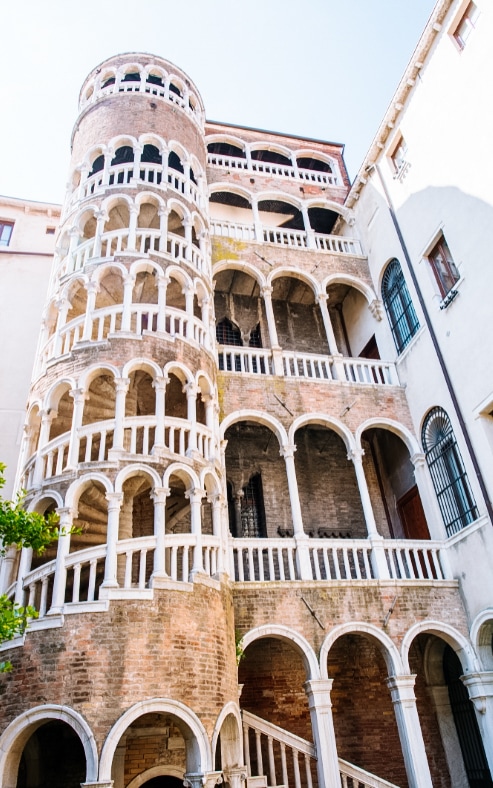

Upstairs you will find a terrace overlooking the city and on the second floor a room with paintings by Tintoretto.
Opening hours are daily from the end of February 10:00-18:00 and in winter 9:30-17:30 (last entry always 30 minutes before). Tickets for 9 € you can book in advance. Children up to 11 years of age are admitted free of charge, young people up to 26 years of age and seniors over 65 years of age pay a reduced admission fee of € 6.
10. Church of St. Zacharias (Chiesa di San Zaccaria)
To the east of Piazza San Marco is the Church of Saint Zacharias, which you shouldn’t miss. There’s something special about it and not many tourists come here. The church looks quite inconspicuous from the outside, but its crypt contains the body of Saint Zacharias and 8 other Doges.
The crypt is flooded with water from the canals and the graves emerge from it as small islands. It has a vaulted ceiling with columns that creates a mirror effect.

The church was rebuilt twice in the Northern European Gothic style, which is unusual for Venice, and later in the Renaissance style. Almost every wall is covered with mosaics, paintings or frescoes. The sacristy with paintings by Tintoretto and Tiepolo is also worth seeing.
Admission to the church is free, but you have to pay extra for the crypt and sacristy. It is open Monday to Saturday 10:00-12:00 and 16:00-18:00 and on Sundays only in the afternoon 16:00-18:00.
11. Gondola ride
A gondola ride can seem like a touristy and expensive pastime to many. And they’re right. On the other hand, a gondola ride is a part of Venice and it takes you to places you don’t normally get to see.

Most of the gondolas can be found near the main attractions. Do you find a lot of them? It’s only a fraction of how many gondolas used to be here. In the 17th and 18th centuries there were 10,000 gondolas in the canals of Venice. Today there are less than 300 of them and they are primarily used for tourist purposes.
From 11th century, gondolas were the main form of transport and until the mid-20th century, the Venetians used them daily. Cruise rates are regulated by the City, so it is not possible to negotiate a lower price.

The price for a 30-minute gondola ride is €80 during the day and after 19 in the evening. 120 € per hour. The price is valid for the whole gondola, i.e. 6 people. You can buy in advance shared gondola ride for 30 € per person.
You can board the gondola in Venice at several locations. The most popular is the promenade of Piazza San Marco. However, be aware that there are queues for the gondolas near the main attractions and it may take a while to get on.
Read: The Complete Guide to Transport in Venice
12. Grand Canal
The most famous and largest canal in Venice. The Grand Canal is 4 km long and separates one half of Venice from the other.
You can cross the canal by one of the bridges (see next point) or by vaporetti (water buses), water taxis, gondolas or traghetti (large gondolas, ferries mainly for workers).
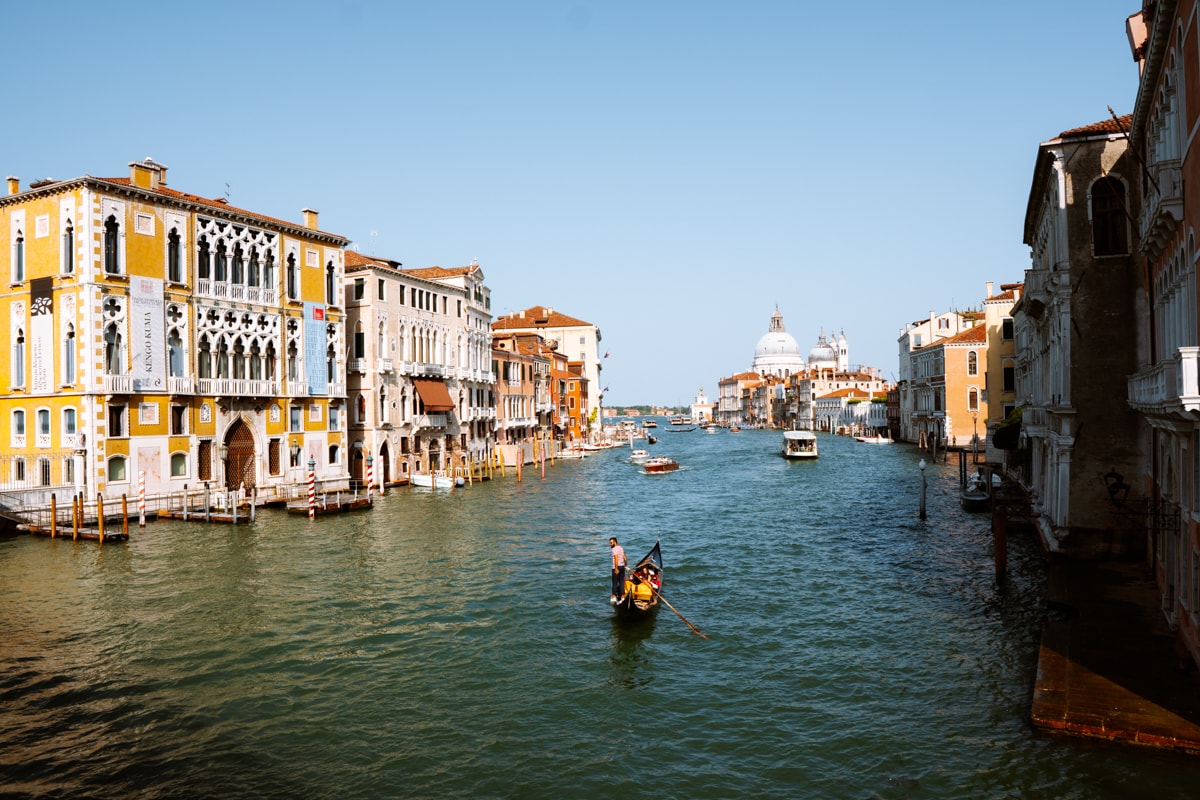
For us I recommend to choose vaporetto – line 1 or 2. These will take you past the most famous sights in Venice – Palazzo Ca´d´Oro, Gallerie dell´Accademia, Palazzo Ca´Rezzonico, Santa Maria della Salute and more.
The disadvantage is that they are often full and you don’t get much out of the trip. We took an early morning ride and were in the vaporetto with only a few locals.

13. Rialto Bridge (Ponte di Rialto)
The most famous and oldest bridge in front of the Grand Canal. And also the most iconic and photographed. That’s the Rialto Bridge, where there’s a queue for most of the day to get your photo taken.
The 400-year-old bridge is one of the 4 bridges that cross the famous canal. Until 19th century, even these bridges were the only way you could cross the canal.

The Istrian stone bridge consists of 3 parallel staircases – 2 are on the edges and the central staircase is flanked by shops selling souvenirs, Murano glass and jewellery.
The Rialto Bridge connects the San Marco district, with the Doge’s Palace and St Mark’s Basilica, to Venice’s oldest district, San Paolo, with the Rialto Market.
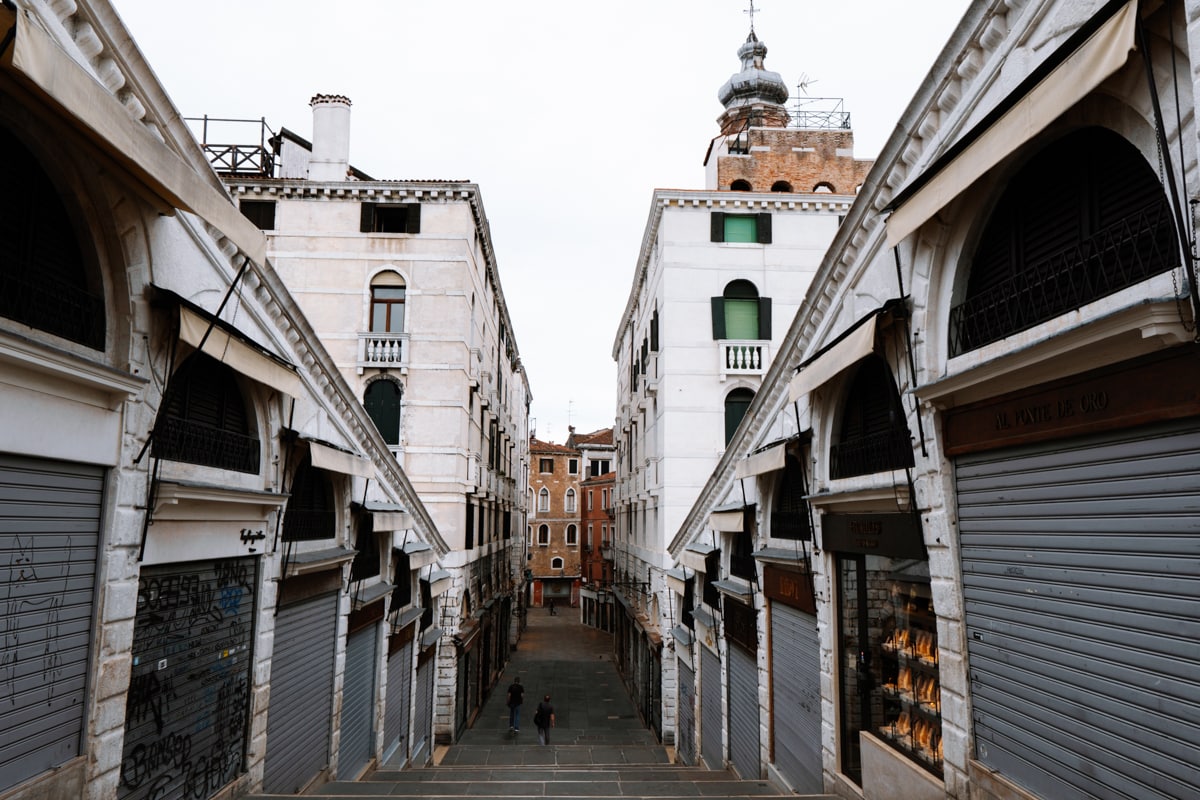
14. Rialto Market
Since I mentioned the Rialto market, let’s talk more about it as well.
To reach the market, walk in the direction from Piazza San Marco across the Rialto Bridge and past the Church of San Giacomo di Rialto (note the distinctive clock on the facade). It is the bridge that gives the market its name.
It’s a place full of colourful fruits, vegetables and spices (the erberia section of the market) in conjunction with the famous fish market (the pescaria section of the market). But besides that, you can also buy other Italian delicacies.

The market existed here at the beginning of the 11th century, but was destroyed by fire, as was the surrounding neighborhood. That’s why most of the construction around the market is of 16th century. The name Rialta comes from the word rivolaltus, translated solid ground that is never flooded.
The fresh produce market is open Mon-Sat 7:30-13:00 and the fish market Tue-Sat 7:30-13:00.
Hotels in Venice 😴
15. Dorsoduro district
The Dorsoduro is one of the six sestieri, Venice’s municipal districts, directly connected to the Ponte dell’Accademia bridge. Located between the Grand Canal and the Giudecca Canal, it is a quiet corner of an otherwise busy city. If you want to experience authentic Venice, head here.
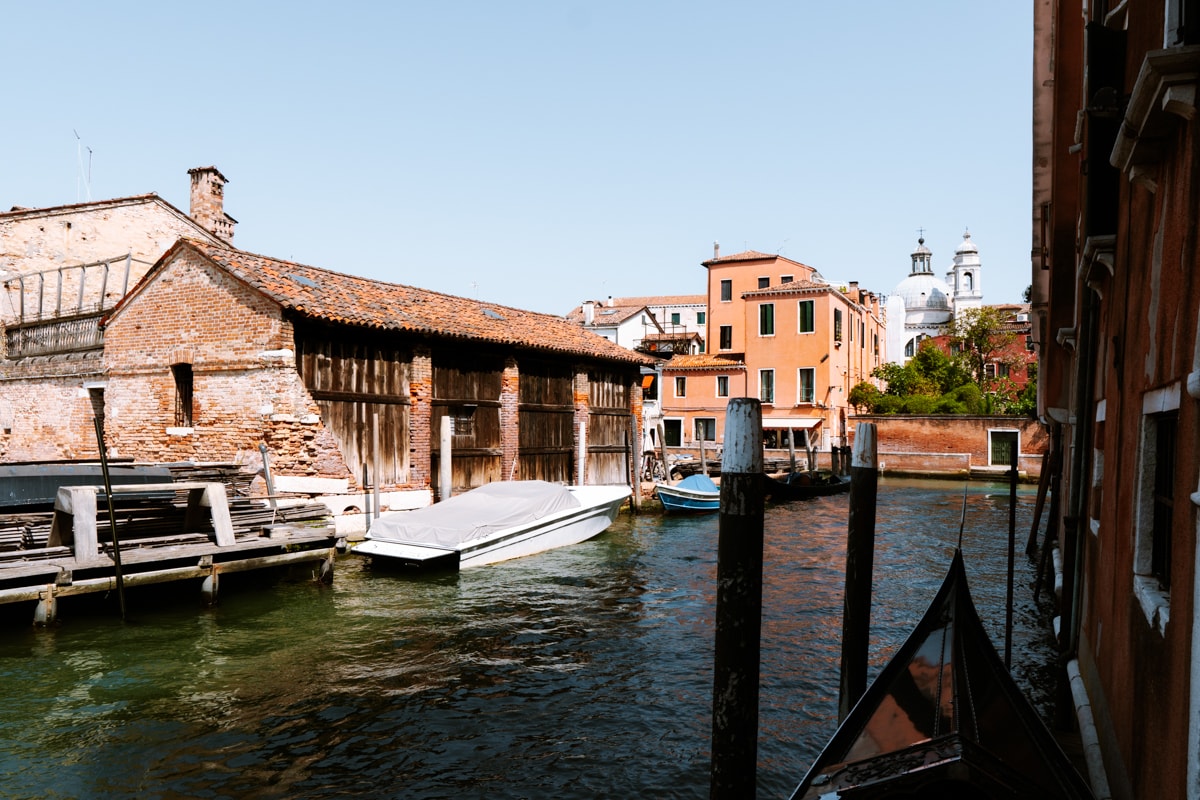
It is home to the Gallerie dell’Accademia, a leading collection of Venetian art, and the Peggy Guggenheim Collection, one of the finest collections of modern art in Italy. Thanks to Venice’s Ca’ Foscari University, the neighbourhood exudes a lively and youthful energy.
The whole of the Dorsoduro district is lined with a landscaped promenade around the Giudecca Canal, which is much quieter than the promenade by Piazza San Marco. Moreover, the sunsets from here are beautiful.

16. Basilica of Santa Maria della Salute
The Basilica of Santa Maria della Salute is known as La Salute for short. Baroque church built to celebrate the end of the plague in 1631. The building with an octagonal plan in the shape of a crown was designed by architect Baldassare Longhen.
Inside you will find a sacristy with 12 works by Titian or art by Tintoretto. Most of them depict the theme of the plague.

On 21 November, the Feast of the Presentation of the Virgin Mary takes place, during which an improvised bridge is installed across the Grand Canal to the Basilica. It symbolizes the liberation of Venice from the plague.
Admission to the basilica is free. You can visit it daily from 9:30-12:00 and 15:00-17:00.
Read: Itinerary for 1 day in Venice
17. Basilica of San Giorgio Maggiore
The Basilica of San Giorgio Maggiore will probably catch your eye with its 2 interconnected facades. They symbolise the harmonious combination of Renaissance Christian ideals with ancient Roman temple design.
The basilica occupies almost the entire islet directly opposite the Palazzo Ducale. That is why it is one of the most photographed places. Gondolas in front and a beautiful white marble basilica behind.

And even inside, you’ll find some real gems. For example, the paintings of The Last Supper or The Burial of Christ and the Fall of Manna by Tintoretto or Madonna enthroned with the saints by Sebastiano Ricci.
The basilica includes a bell tower that is almost as tall as the one in St Mark’s Square. The elevator will take you up, which is located together with the ticket office on the left side of the basilica (inside). For €8 you get a great view of Piazza San Marco and, in good visibility, the Alps. Entrance to the basilica is free.
From April to October, the Basilica of San Giorgio Maggiore is open 9:00-19:00 and the rest of the year 8:30-18:00.
Read: How to get from Marco Polo Airport to Venice


18. Basilica of Santa Maria Gloriosa dei Frari
The Basilica of Santa Maria Gloriosa dei Frari is a Gothic basilica with a brick facade, known as I Frari for short.
It is hidden among the narrow cobbled streets, but once you get there, it will take your breath away with its magnificence. It is known for its art collection including sculptures and paintings by Donatello, Alessandro Vittoria, Titian, Bellini, Alvise and others.
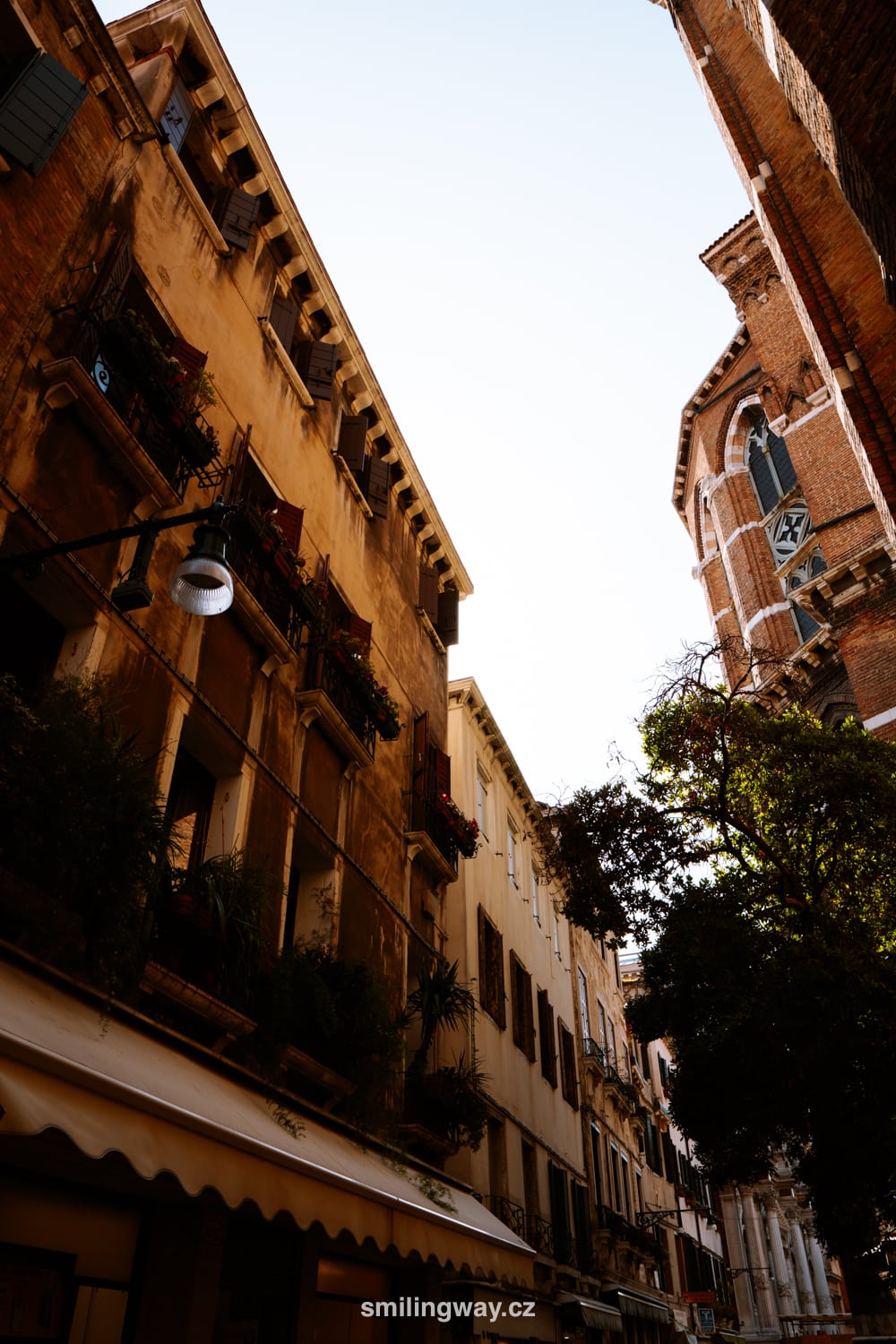
The Basilica is open Monday to Saturday 9:00-18:00 and Sunday afternoons 13:00-18:00, in high season until 19:30. The last entry is always half an hour before the end of opening hours.
Admission is 5 € (under 11 years free, students 2 €, over 65 years 3 €).

19. Scuola Grande di San Rocco
Behind the Basilica of I Frari stands the most interesting of the Great Schools of Venice. The Scuola Grande di San Rocco is the best preserved of the 6 Venetian fraternities. These fraternities are religious institutions that serve to provide charitable services to the poor.
The Scuola Grande di San Rocco is dedicated to Saint Rocco of the 16th century, the patron saint of the plague. Today it is visited by tourists for its interiors.

Have you seen the Sistine Chapel at the Vatican? The Scuola Grande di San Rocco has exactly the same meaning for Venice. Just as Michelangelo decorated the ceiling of the Sistine Chapel, Tintoretto decorated the walls and ceiling here. It took him 24 years and it’s definitely worth seeing even if you’re not a fan of art.
It is open daily 9:30-17:30 and the entrance fee is 10 €.
20. Jewish Ghetto
In the north-west of Venice, in the Cannaregia district, there is a Jewish ghetto. It was founded in 16th century and just about the first ghetto in the world. At that time, Jews were only allowed to come out during the day and were guarded at night.
Despite its sad past, today it is a lively area full of restaurants, bars, shops, museums and synagogues. There are far fewer tourists here than in the centre of Venice.

At the Museo Ebraico (Jewish Museum), you can get a closer look at Jewish history, art and culture.
Open daily except Saturday 10:00-17:30 and Thursday until 18:30. The entrance fee is 12 € including a visit to two synagogues.
Read: How to get from Treviso Airport to Venice
21. Basilica of St. John and St. Paul (Basilica dei Santi Giovanni e Paolo)
The Basilica of Saints John and Paul is the largest church in Venice, which is a bit off the main beaten track next to the Venetian Hospital on Campo Santi Giovanni e Paolo.
The building is nicknamed the Church of Chandeliers because of the number of chandeliers that decorate its interiors. In addition, there are the tombs of 27 Doges and several important paintings by Bellini, Veronese and Piazzetto.
Open 9:00-18:00 and 12:00-18:00 on Sundays. Admission is only 3,5 € (children 1,5 €).


22. Alta Acqua Bookstore (Libreria Acqua Alta)
On the way to the basilica, you can take it through the unusual Acqua Alta bookstore. It’s a bit hidden, but worth seeing. The books are stored here in tubs, canoes or even in a gondola to survive the Acqua Alta (the big water in Venice).

There is a staircase of books on the back porch, which you can climb up to see the canal beyond.
23. Church of the Holy Redeemer (Chiesa del Santissimo Redentore)
The Renaissance church of Santissimo Redentore, or I Redentore for short, may not be as well known and is a little off the beaten track outside of the main Venice, but it’s worth seeing. The church can be found on the island of Giudecca, south of the centre of Venice.
The church of I Redentore was designed by the architect Palladio (like the more famous Basilica of San Giorgio Maggiore) and symbolizes thanksgiving to God for saving the city from the plague. After his death, the church was completed by Antonio da Ponte (architect of the famous Rialto Bridge).

I Redentore is characterized by a white marble facade combined with a brick exterior. Palladio’s design was inspired by ancient temples. Inside is a collection of paintings by Veronese, Bassanos and Tintoretto.
Open daily except Sunday 10:00-16:45. Admission is €3 (children under 11 years old get in free and students pay a reduced rate of €1.5).
24. Venice Shipyard (Arsenale di Venezia)
The Arsenale di Venezia is a place that until a few years ago was not open to the public. Definitely worth seeing if you are interested in maritime themes.
Arsenale di Venezia is a Byzantine shipyard dating from 1104. A vast area consisting of docks, ship factories and wharves. Hence the name arsenale, which translates as shipyard. A number of events are currently taking place here. For example, the Venice Film Festival or the fireworks during the Venice Carnival.

The complex includes the Maritime History Museum, the most important in Italy. The exhibition area is divided into 5 floors and a total of 42 exhibition rooms. In the ancient workshop of the oars there is the Boat Pavilion.
For up-to-date information, check the official website of La Biennale.

25th Venetian Carnival
You can’t miss the Venetian Carnival here. It’s one of the first things that comes to everyone’s mind when they say “Venice”.
Did you know that masks were banned at certain points in Venetian history? The reason was simple. People were able to indulge in activities that were not sanctioned by the church. And crocheting wasn’t :). But masks also made it possible to hide age, social or economic circumstances for a few days. Everyone was equal.

You can buy a Venetian mask today for a few euros in a plastic version or for thousands of euros, where the mask is a perfect work of art. The Venetian Carnival takes place during February for 10 days until Ash Wednesday.
5 tips for day trips around Venice
1. Murano
Murano Island is just 1.5 km from Venice. It is the second largest island in the Venetian lagoon and is famous for its glass production. That is why it is called the Island of Glass. Centuries-old techniques are still used in the production process, so watching the glassmakers at work is a unique experience.

Worth a visit on Murano is one of the oldest churches in the lagoon, the Church of Santa Maria and San Donato, and the Museum of Glass with more than 4,000 objects and a chandelier weighing 300 kg.
The island of Murano can be reached by several water bus lines – you can find a map here.

2. Burano
The island of Burano is further away from Venice – about 45 minutes by water bus, but it’s definitely worth the trip and if you’re able to make it, take a trip here.
Burano is known for its lace making, leaning bell tower and iconic colorful houses. Locals can’t even choose the colour of the facade themselves. It is assigned to them according to their place of residence. According to legend, the houses were painted in bright colours so that sailors could find the island better in foggy weather.

1-2 hours will be enough to explore the island. You can get here by vaporetto line no. 12 from Fondamenta Nuovo or no. 14 from San Marco Zaccaria. Right next to the island of Burano is the can’t-miss island of Torcello.

3. Torcello
Standing here, it seems almost unbelievable that the island of Torcello used to be the most populated and important island in the lagoon. A malaria epidemic killed many of the inhabitants and only a handful of the original 20,000 remain. Power then shifted to Venice.
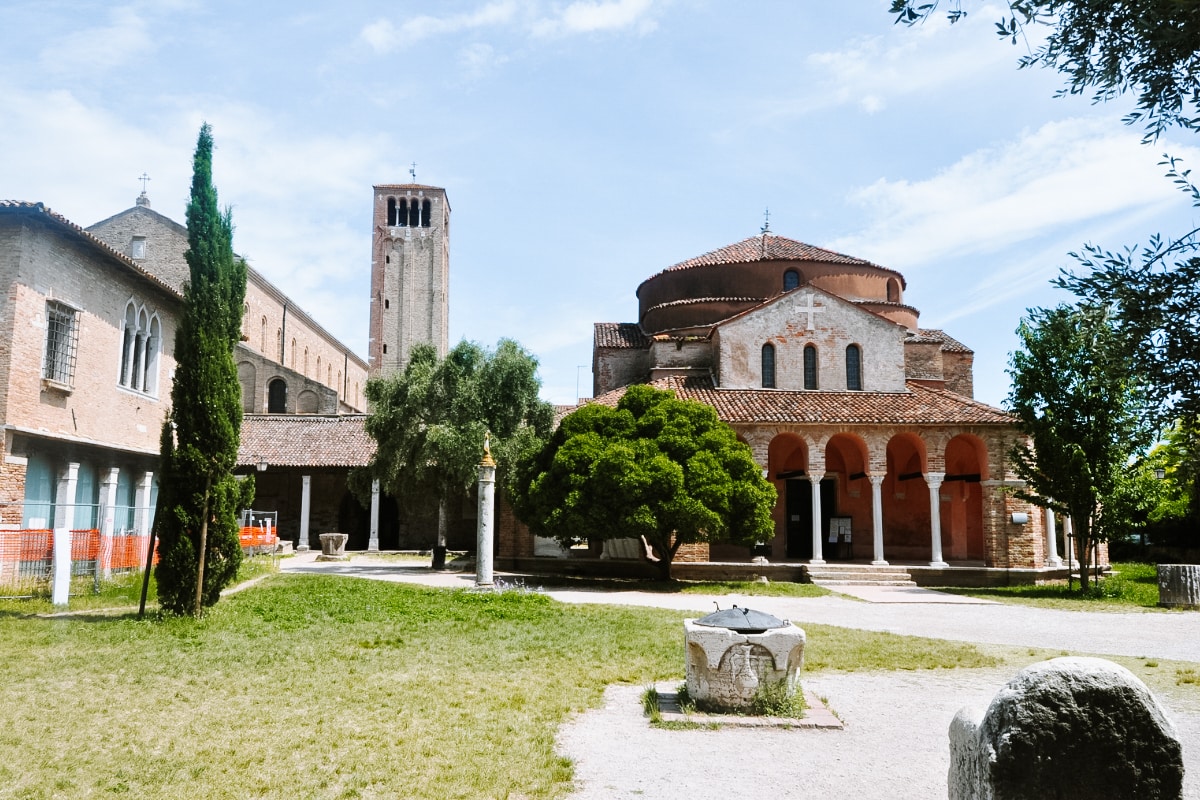
Torcello Island is like going back in time. The sleepy rural atmosphere contrasts with the lively Venice. You will find several souvenir shops and the Attila’s Throne, or the ancient stone chair that legend has it was used by King Attila of the Huns. The oldest building in the Venetian lagoon, the Cathedral of Santa Maria Assunta with its Byzantine mosaics from the 12th and 13th centuries, is particularly worth seeing. You can also climb to the top of the bell tower.
The island can be reached by the same line as Burano Island or from Burano by water bus.
TIP: You can visit all 3 places (Murano, Burano, Torcello) visit in one trip.
4. Villa Pisani on Stra
Villa Pisani on Stra is a sprawling Baroque palace from the 18th century, built as a tribute to the owner Pisani (114th Doge of Venice). Later the villa was bought by Napoleon and then by the Habsburg family. Inside the palace, you can see Napoleon’s bedroom, which is still intact, and the rich frescoes.
The complex includes 11 hectares of French and Venetian style gardens, an orangery, statues, a small forest, a café and a labyrinth with a lookout tower in the middle. In front of the palace is a swimming pool, which mirrors the building itself.
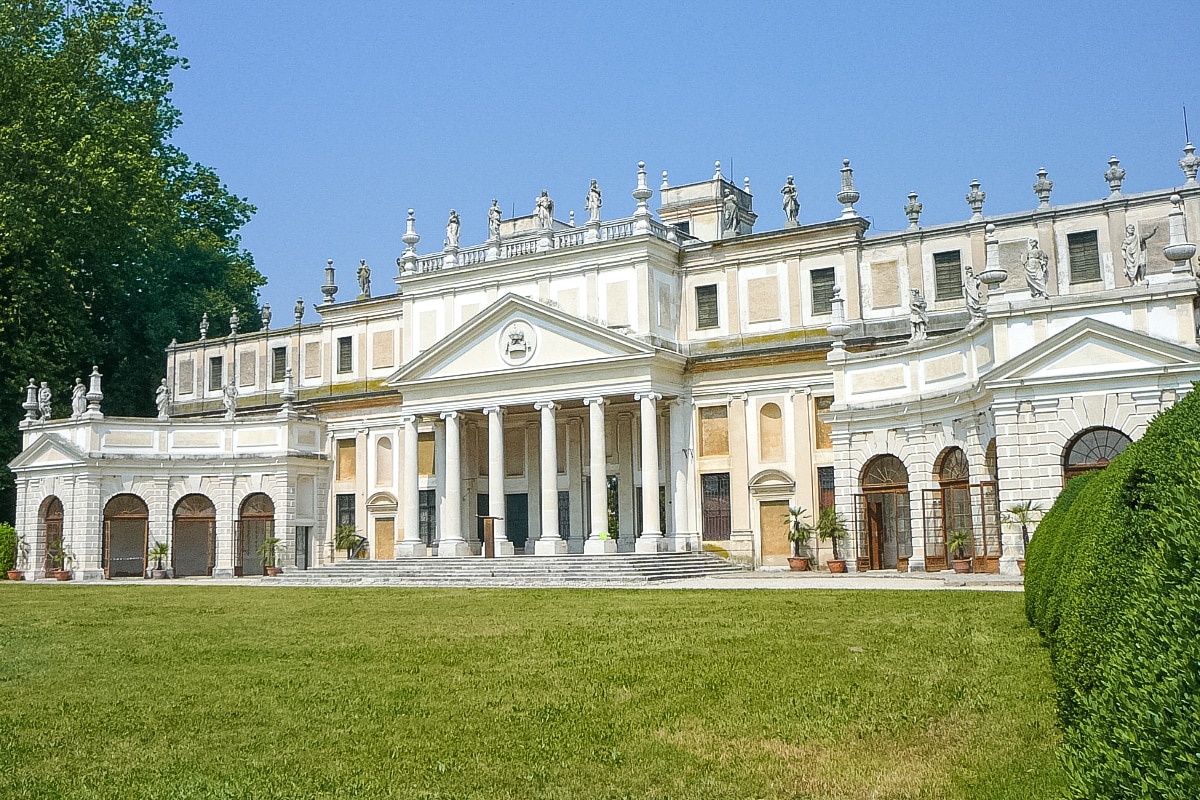
The palace can be reached in less than an hour by direct line 53E from Venice (Piazzale Roma). Opening hours vary according to the season. On weekends it is open almost all day. On Tuesdays and Thursdays the palace is open in the afternoon and on Wednesdays and Fridays in the morning.
Admission is 8,50 € (reduced 3 €). It’s closed on Mondays. It is better to make booking in advance.
5. Padua
Padua is a city that lives in the shadow of the more famous Verona and especially Venice. But this has an advantage – it’s not a headache and you can explore the historic part of the city in peace. It is only half an hour from Venice.

Padua was founded even earlier than Rome. Moreover, at the end of the First World War it was the second richest city in Italy after Rome. It has a rich artistic and historical heritage with numerous preserved monuments.
Take in the Basilica of St Anthony, the San Giusticia Cathedral, the Palazzo della Ragione with its magnificent medieval town hall, the Scrovegni Chapel with its frescoes (said to be the first masterpiece of the Italian Renaissance) or the University of Badua Botanical Garden, the oldest in the world.

Where to stay in Venice
Accommodation in Venice
If you want to enjoy the atmosphere of Venice, accommodation in the old town is the best choice. The whole island part of Venice is well connected by vaporetto and water taxi, so you can reach Piazzale Roma in no time, with connections to the airport and places around Venice.
- Antico Panada: A budget and cosy hotel right in the centre of Piazza San Marco
- Hotel Belle Arti: Three-star hotel in the artistic district of Dorsoduro, located a few minutes from the Grand Canal and San Marco Square.
- Hotel Il Moro di Venezia: Cheap, clean hotel 5 minutes from Piazzale Roma, with private bathroom and air conditioning
Accommodation in Venice 😴
Accommodation in Mestre
Mestre is a populated urban area on the mainland of Venice – it is located before Piazzale Roma and at the beginning of Ponte della Libertà. Venice’s Piazzale Roma can be easily reached in a few minutes by bus, tram or train.
Mestre is a great choice for those travelling by car, wanting a quick connection to the airport or looking for cheaper accommodation in Venice. It doesn’t have the atmosphere of Venice with its water canals, but it provides good facilities.
- Hilton Garden Inn Venice Mestre: Four-star modern hotel with great value for money, swimming pool, spa and excellent cuisine
- Hotel Alverì: Three-star comfortable hotel at a good price and with free parking
- Camping Venezia Village: Modern accommodation in self-contained bungalows with fridge and terrace, the complex also has a swimming pool, playground, restaurant and shop
- Hotel Delle Rose: Cheap but clean and pleasant hotel with good access to the airport and Venice
Accommodation in Venice 😴
Tips on the best places and things to see in Venice: MAP
HOW TO USE THIS MAP: Above you will find a detailed map of Venice with tips on sights to visit. Click at the top left of the map to see separate layers with highlighted locations. You can hide and show the different layers or click on the icons on the map to see the names of the places I mention in the Venice guide. If you want to save the map, star it. For a larger version, click on the icon in the upper right corner.
Practical information on how to enjoy Venice
Parking
Parking in Venice: what are the prices, where to park to keep your car safe and how to get to the centre afterwards, see the separate article on parking in Venice.
Public transport and vaporetto in Venice
Multi-day ticket for the vaporetto and the entire public transport – If you want to enjoy Venice, you can’t do without a water bus. I recommend taking lines 1 or 2, which take you past the Grand Canal and the main points in Venice (line 2 has fewer stops).
One cruise costs €9.50, so multi-day tickets are usually worthwhile (24 hours for €25, 48 hours for €35, 78 hours for €45). This includes unlimited bus and tram rides in Mestre and water lines to nearby islands (Burano, Murano, Torcello, Lido and others). Valid for the selected number of hours from the first activation in the yellow machine (at stops).

Looking for ways to get from the airport to Venice? Here are tips on how to get to Venice from Marco Polo Airport. Flying into Treviso Airport? In this article you will find ways to get from Treviso Airport to Venice.
How to save in Venice
Venezia Unica City Pass – A tourist card that includes access to a wide range of monuments and museums in Venice (Doge’s Palace, La Fenice Opera House, churches, museums) and public transport. The price varies depending on how many sights you choose, where you plan to use public transport and how old you are.
Ticket to Piazzale Ducale – The queues for the Doge’s Palace are long. That’s why it’s better to buy a ticket in advance so you don’t waste time in a long queue. The ticket is also valid for the Museo Correr, the National Archaeological Museum and the National Library of Marciana.
Please note: In 2024, an entry fee for Venice has been introduced for selected days (weekends and public holidays from April to July). For more information, see our article (link opens in a new window).
These were our 30 tips for the most beautiful places and sights to visit in Venice. Do you have a question? We’ll be happy to answer it in the comments below. Have a safe journey!
More information about Italy
VENICE: Get inspired with our itinerary for 1 day in Venice. We’ve also prepared an itinerary and route for 2 days in Venice + options if you plan to spend more time in Venice.
In the article about parking in Venice, you will learn everything you need to know about parking if you are driving. We have also prepared a detailed guide to transport in Venice.
As of 2024, there is now an obligation to pay the fee to enter Venice on selected days.
Looking for ways to get from the airport to Venice? Here are tips on how to get to Venice from Marco Polo Airport. Flying into Treviso Airport? In this article you will find ways to get from Treviso Airport to Venice.
VERONA: Check out the best places to visit in Verona (including useful information on entrance fees and opening times). Also included is a guide with additional tips (transport, accommodation, food, Verona Card). The Verona in a day itinerary will help you plan your route.
ITALY: Get inspired by the most beautiful places in Italy.
ROME: Rome is one of the most popular cities in Europe. Here’s a list of the best things to see in Rome. Build your 3-day Rome itinerary and see how to save in Rome. Find out all about the Vatican Museums or the Colosseum.
DOLOMITES: One of the most beautiful mountain ranges in the world can be found in northern Italy. What to see in the Dolomites is in a separate article. In the Dolomites guide we share useful tips on how to plan your trip to the Dolomites.
Read even more tips on travelling in Italy.
Summary: What to see and do in Venice
Venice has wonderful sights and places that are among the most beautiful in Italy. The famous Piazza San Marco with its ornate basilica and Doge’s Palace, the churches will amaze you with their grandeur on the outside and their ornate interiors on the inside, or the charming streets with hidden corners where there is always something to discover. In this article, we’ll show you 33 places to go in Venice, including a map of the sights to help you plan your itinerary.
It’s not just Venice you can visit. Other nearby attractions include the glass-making island of Murano, the colourful island of Burano and the historic city of Padua.
Venice is not big. You can walk through the centre in one, but if you plan to enjoy it more and visit some of the sights from the inside, I would recommend 2-3 days. There are plenty of nooks and crannies and interesting places to see too. In addition, you can take a trip to the nearby islands of Burano and Murano, which takes about half a day.





